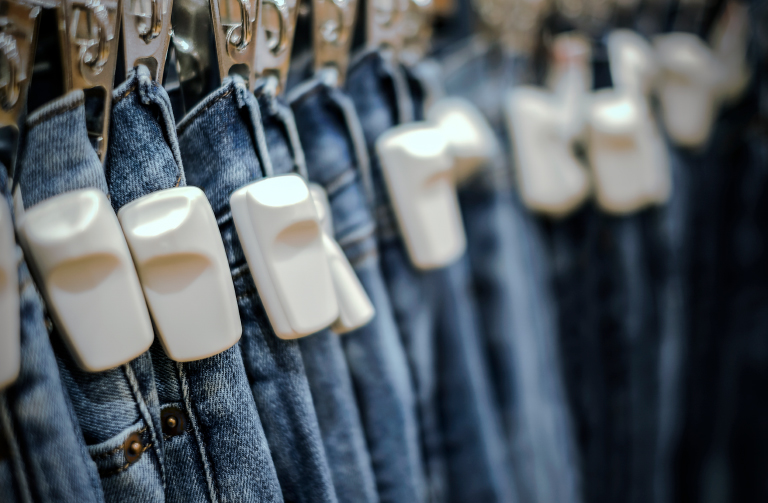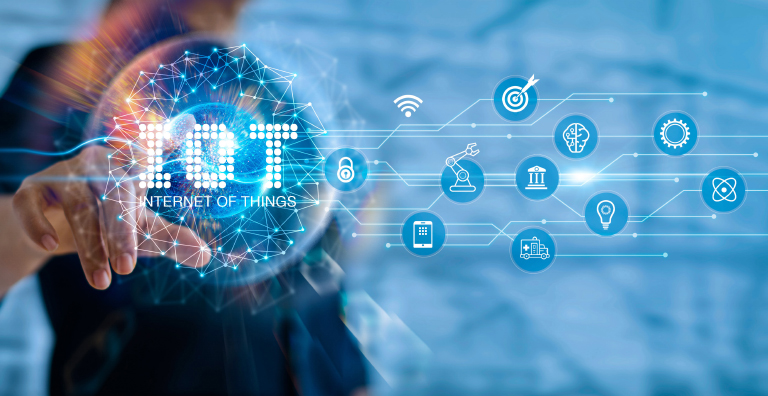HID Supports an Array of IoT Technologies
Fifty years ago, the internet, let alone the Internet of Things (IoT), didn’t even exist. Today, the IoT spans billions of devices enabling a spectrum of use cases from short-range, consumer contactless payment cards to industrial asset tracking devices that can communicate over many miles.
According to Global Data’s latest report, the IoT industry is expected to be worth over $1 trillion by 2024. Alongside IoT investment, IoT revenue is expected to grow year-over-year between 2019 and 2030. The IoT market is currently worth approximately $800 billion.
This incredibly lucrative market offers revenue-generating opportunities for virtually every industry, from manufacturing to healthcare and so much more.
How HID Fits Into the Ecosystem
HID enables leading enterprises to keep track of business-critical assets, whether they’re traversing the globe or orbiting it.
While HID is best known for developing RFID devices for the automotive, manufacturing, logistics, aerospace and energy sectors, it is a product-based company not a technology company. This allows the R&D team to be technology-agnostic, using open standards and embracing new technologies to fit market requirements. We rapidly gain expertise in new technologies and use them to solve specific problems for our customers and partners.
This article traces some of the key technologies that make up the IoT today and where HID products can support your business requirements tomorrow. While it’s tempting to think of pervasive connectivity as a modern phenomenon, the IoT runs on a range of tried and trusted technologies that have been developing for almost a century. These include:
Bluetooth® Wireless Technology
The origin of Bluetooth® technology can be traced back to 1994 when Dutch engineer, Jaap Haartsen, began developing a way of using short-range wireless technology to connect cellular and mobile devices. His system laid the foundations for Bluetooth® wireless technology and over the next decade Haartsen helped to drive the standardization of the Bluetooth® radio interface through the Bluetooth® Special Interest Group.
Named after 10th century Danish king, Harald ‘Bluetooth’ Gormsson, who united the tribes of Denmark and Norway, today Bluetooth® technology offers short-range wireless connectivity between millions of everyday devices, from wireless speakers to contactless payment systems.
Application of the Bluetooth® protocol has exploded in recent years thanks to a powerful combination of low power consumption, easy connectivity, optimized data rate and a good communication range in comparison to WiFi. This allows for battery-operated devices such as our Sense Bluetooth® Low Energy range to operate for up to five years in harsh conditions without a change. This has led to Bluetooth® technology becoming the unchallenged de-facto standard for battery-powered consumer devices, in turn spurring an immense investment in silicon and batteries. Bluetooth® technology is now poised to make the transition into the industrial arena, hitherto the preserve of 433 MHz and similar standards, and it is bringing with it an array of relatively low-cost microprocessors and sensors.
In addition to the standard profiles and protocols, such as iBeacon and Eddystone, several very interesting and somewhat more exotic applications of the base protocol have sprung up, such as Quuppa and Wirepas.
Quuppa and Wirepas
Compared to better-known technologies such as UWB, Quuppa offers the advantage of using relatively lower-cost asset tracking tags with industry-leading location accuracy. However, it does require a higher infrastructure investment. This makes Quuppa an ideal technology choice when you need to know an asset location with a good degree of precision, in a contained area such as a warehouse, production cell or critical personnel areas.
Described as providing 5G IoT without relying on a cellular network, Wirepas provides an approximate location of assets; however, as the Wirepas Mesh protocol software operates on any device, radio frequency or radio chipset, this substantially reduces the cost of deployment for industrial applications such as smart buildings.
As mentioned, HID is a product-based company that embraces new technologies to meet customer use case requirements. Earlier this year, three new devices that incorporate Quuppa’s highly accurate location technology were added to the Sense range of IoT devices. The Sense Shield is a wearable device that is ideal for pinpointing the location of lone workers and can be applied to a range of health & safety and healthcare applications. The Sense Bluetooth® Low Energy asset tracking device can now be Quuppa-enabled to provide additional location accuracy. The technology was piloted at the Oval cricket ground in the UK to test whether sporting venues could be safely re-opened with appropriate social distancing.
LoRa
HID is a member of the LoRa Alliance, and the Sense range offers long-range communication for logistics and asset management applications. The LoRaWAN standard is used in more than 100 countries, with an extensive ecosystem of partners and offers good coverage, particularly in Europe. This provides the benefit of a high level of interoperability between devices, at a lower operating cost than cellular networks.
RFID
As mentioned, HID is well-known for its RFID devices. This particular IoT technology has been evolving for more than eighty years. The first use of RFID was for Identification Friend or Foe (IFF) in the 1940s. Used in conjunction with wireless radio, a passive transmitter on the aircraft allowed the air force to use radar to direct their own aircraft to maximum effect.
This early use case triggered international research into the use of radio frequencies to remotely identify assets, which gave rise to the myriad of consumer applications that surround us today.
LF RFID
Livestock identification using low frequency RFID (LF RFID) began to be commercialized in the 1950s, which led to LF RFID being more widely adopted for tracking assets such as rail freight containers in the 1960s.
HF RFID
The use of high frequency RFID (HF RFID) for access control in hospitals, hotels, businesses and cars stems from two ground-breaking inventions that were patented in the early 1970s.
Passive RFID Tags
In 1973, American electrical engineer Charles Walton filed a patent for his invention of a “portable radio frequency emitting identifier” — a passive RF tag that was activated when held within six inches of a radio transceiver and which could be used to unlock a door without using a key. Walton’s invention was the first to be labelled as an ‘RFID’ device. He was awarded a total of ten RFID patents, including a digital version that allowed data to be changed on key cards.
Active RFID Tags
Meanwhile, in 1973, another American inventor Mario W. Cardullo, was awarded the patent for an active RFID tag with basic read/write memory and the ability to transmit information using its own power source. Cardullo’s inventions formed the basis of modern RFID toll booth systems and keyless ignition fobs used to combat auto theft.
UHF RFID

Nine years after signing their global cooperation agreement, in 1999 EAN and UCC launched the Auto-ID Center to develop Electronic Product Code (EPC) enabling GS1 standards to be used for RFID.
So, UHF RFID actually involves a whole range of technologies that were brought together within the GS1 EPC and had already been in development for half a century.
NFC
Based on passive RFID, near field communication (NFC) technology developed in 2002 and was approved as an ISO/IEC standard in 2003. NFC uses the same 13.56 MHz spectrum as proximity RFID tags and contactless smart cards, and enables two-way communication between devices when they are held within four centimeters of each other. It supports encryption, and since it is difficult for messages to be intercepted because the devices need to be so close together to communicate, it has been used for a range of security applications and contactless payment systems, including mobile wallets. This development is bolstered by the fact that hundreds of companies, including banks, handset manufacturers and retailers have joined the NFC Forum. In 2012, Best Buy, Walmart and Target formed the Merchant Customer Exchange (MCX).
Future NFC applications include smart packaging, smart metering and smart marketing, where customers can use their mobiles to scan products for more information, to benefit from special offers and to place orders.
Where Are We Now?
From an industrial perspective, we are starting to see pervasive use of RFID which began with large-scale implementations in the apparel retail sector and received an exponential boost as billions of Bluetooth® technology and NFC readers were incorporated into the smartphones in everyone’s pockets.
Like ink on blotting paper, as a technology proves its worth in one business application, it then spreads into other sectors as diverse as recreation, oil & gas, construction, waste management and medical asset tracking within hospitals.
More recently, we’ve seen technologies being combined within Bluetooth® Low Energy NFC devices.
Although it’s designed as a consumer product, I believe it is fair to say that the Apple AirTag is a landmark product for the IoT market as a whole because it’s a UWB Bluetooth® Low Energy NFC device running a combination of different technologies. While the $40+ price tag is relatively high, and as an Apple device, the AirTag uses proprietary protocols, it’s very interesting to see Apple producing what is effectively an IoT-based asset location tag for the consumer market. This is a key intersection between consumer and industrial IoT that has the potential to drive a host of new developments.
Where Are We Heading?
The growth in the UHF RFID arena is also seeing adoption in complementary technologies, such as Bluetooth® Low Energy, Quuppa and Wirepas. These are being added to our products as a result of customers’ and partners’ requests, and which demonstrate just how far consumer technology is reaching into the industrial arena.
We’re also seeing requests for the incorporation of longer-range technologies, further extending the complementary solutions to meet new use cases within the logistics and industrial energy arenas.
This is a hugely exciting time to be working in our industry. I firmly believe that we’re on the cusp of the next generation of UHF RFID and an IoT revolution.
Where Are We Seeing Growth?
We’re seeing a growing number of new IoT opportunities where companies want to combine NFC with UHF RFID to deliver logistics and asset management efficiencies and also to enhance the customer experience in a dual industrial/consumer application. Some examples include:
Consumer Energy
In countries that don’t have piped gas, there is a demand for tracking gas canisters used for domestic energy. A project is entering its rollout phase in Asia where UHF RFID is used for logistics to track millions of domestic gas canisters, and the NFC component is combined with an app to allow fresh supplies to be ordered via customers’ smartphones. This is a perfect example of the market embracing technology and using industrial RFID in combination with NFC to enhance customer experience, engagement and loyalty by making it easier for people to return and reorder domestic gas canisters.
Smart Cities
Another project combining RFID and NFC is a maintenance, repairs and operations application that uses the NFC component, embedded within assets, to communicate directly with a field service engineer’s device, allowing the relevant authority to create an audit trail showing when each asset is moved, maintained or replaced.
Reusable Packaging
A producer of dairy products, which are currently transported in single-use cardboard boxes, is looking at embedding RFID within reusable corrugated plastic boxes to achieve efficiency gains across more than 20 million reusable boxes. This is a similar application to that of Keg Hounds, which selected HID to develop a waterproof, robust, durable passive RFID tag for metal beer keg chimbs, which significantly reduces shrinkage and loss for breweries.
When we talk about the Internet of Things, it’s not just putting RFID tags on some dumb thing so we smart people know where that dumb thing is. It’s about embedding intelligence so things become smarter and do more than they were proposed to do. — Nicholas Negroponte, Founder and Chairman Emeritus of Massachusetts Institute of Technology's Media Lab

The Whirlpool Effect of the Intersection of Technologies
As discussed, the IoT involves a spectrum of complementary technologies that have been maturing for decades, with each technology fulfilling a different requirement.
Over the past two decades we have observed a whirlpool effect, where an innovation in one sector accelerates development of a solution in a related industry. This has resulted in technologies that intersect, enhance and advance the whole IoT ecosystem.
As industrial and consumer technologies start to interleave, I genuinely feel like we are on the brink of a technology revolution with a clutch of radically new technologies emerging such as Wiliot, and cellular technologies enabled by the rollout of 5G and 6G.
Ultimately, the IoT technologies that we implement are designed to improve efficiency, tracking and safety — saving our customers time and reducing cost, waste and environmental impact. Whether this involves a complete re-engineering of assets or making the collection of millions of containers more efficient, we’ll be there to support your business in creating the right IoT solution.
Webinar: Why Expansion Is Good for Our Customers and the Industry >>
For a deeper dive into HID’s RFID tags with industry certifications to operate in harsh environments, check out our white paper, The Four Most Important Certifications for Rugged RFID Tags.
David Owen is an integrated Marketing Manager and brand builder with both professional agency and client-side experience. His client-side experience has included the Commercial Property sector with Vail Williams LLP and before that was in the conference, meeting, events and golf industry. In 2019, David joined Omni-ID (now an HID company). David and his family reside in the quiet countryside of Surrey England, where he likes to enjoy a round of golf.
